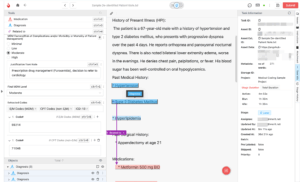If you are building AI for autonomous medical coding, ambient scribing, or documentation summarization, selecting the right annotation solution is critical. From pre-labeling tools to reasoning-first expert workflows, today’s leading platforms vary widely in scope and specialization.
This guide highlights top annotation providers supporting coding model development, with a detailed comparison of features, clinical strengths, and workflow maturity. It also outlines what makes iMerit the trusted partner for training accurate, explainable, and audit-compliant AI.
This overview was developed by iMerit using publicly available information to support AI teams and healthcare innovators in selecting the best-fit annotation service for their coding automation goals.
1. iMerit + Ango Hub
iMerit offers an integrated solution combining its secure platform, Ango Hub, with a curated workforce of certified coding professionals. It supports a wide range of coding systems, including ICD-10, CPT, HCC, and Harmonization, while supporting the end-to-end pipeline with structured expert-led annotation with reasoning capture, label validation, and scalable delivery.
Strengths
- Certified coders (CPC, CCS, RHIT, CCA, AAPC, etc.)
- Expertise across diagnosis, procedure, and risk-adjustment workflows
- Reasoning capture with multistep arbitration and consensus workflows
- Audit-ready pipelines with label-level traceability
- HIPAA, ISO 27001, SOC 2, and GDPR compliance
- Scalable dual-shore, tiered, and multilingual workforce options

This makes iMerit ideal for autonomous coding teams that need clinically accurate, audit-ready data pipelines. We are the only provider combining certified coding experts, structured reasoning workflows, and full-service project delivery built for healthcare AI.
2. Scale AI
Scale provides hybrid annotation services using automated labeling pipelines with human QA for structured and unstructured data. It supports healthcare clients and LLM developers with prebuilt RLHF tooling.
Strengths
- Fast throughput and automation pipelines
- RLHF support for code and summarization models
- Multimodal support, including audio and text
- API-first integrations
Limitations
- Limited transparency on the medical coding domain expertise
- Concerns about vendor neutrality after recent investments
- Lacks built-in audit compliance for medical workflows
3. SuperAnnotate
SuperAnnotate offers flexible labeling tools for audio, text, documents, and images. It supports automation and model-in-the-loop workflows, but clinical accuracy depends on external reviewers.
Strengths
- Collaborative annotation platform
- Custom workflows and SDKs
- Pre-labeling and auto-labeling tools
Limitations
- Internal certified coders or medical coding experts are not included
- Reasoning capture and label traceability workflows are not integrated
- Audit and compliance validation features are limited
4. Dataloop
Dataloop supports advanced annotation for text, audio, and documents, with a focus on RLHF and LLM workflows. It offers APIs, SDKs, and configurable quality rules.
Strengths
- Model-in-the-loop annotation
- Python SDK and QA automation
- Feedback loops for RLHF use cases
Limitations
- Requires integration work and technical onboarding
- No in-house medical domain workforce
- Clinical workflows must be customized externally
5. Sama
Sama provides managed annotation services across NLP and vision tasks with QA-trained reviewers. It supports multilingual projects and domain-specific pipelines, especially for healthcare and insurance.
Strengths
- Human QA teams and an ethical workforce model
- Onshore and offshore options
- Supports healthcare document labeling
Limitations
- RLHF or model-integrated workflows are not included
- Clinical-grade validation tools are not integrated
- Does not have a built-in platform for tool-based annotation
6. Toloka
Toloka uses a crowdsourcing model for high-volume data labeling. It supports text classification, transcription, and structured tasks in multiple languages but is not designed for clinical coding or regulatory workflows.
Strengths
- Scalable and cost-effective
- Language diversity and flexible task formats
- Easy access to annotators via templates
Limitations
- No support for ICD-10, CPT, or risk adjustment codes
- No audit traceability or reasoning support
- No healthcare compliance or security controls
Feature Comparison Table (2025)
| Feature | iMerit | Scale AI | SuperAnnotate | Dataloop | Sama | Toloka |
| Certified Medical Coders | ✅ | ❌ | ❌ | ❌ | ✅ | ❌ |
| ICD-10, CPT, HCC, Harmonization | ✅ | Limited | ❌ | ✅ | ✅ | ❌ |
| Reasoning Capture | ✅ | ❌ | ❌ | ✅ | ❌ | ❌ |
| Pre-labeling and Model Integration | ✅ | ✅ | ✅ | ✅ | ❌ | ❌ |
| Multilingual Workforce | ✅ (26+) | ✅ | ✅ | ✅ | ✅ | ✅ |
| RLHF or LLM Support | ✅ | ✅ | Partial | ✅ | ❌ | ❌ |
| Audit-Ready Label Traceability | ✅ | ❌ | ❌ | Partial | ✅ | ❌ |
| HIPAA and ISO 27001 Compliance | ✅ | ❌ | ❌ | ✅ | ✅ | ❌ |
| Scalable Tiered Workforce | ✅ | ✅ | Limited | Limited | ✅ | ✅ |
Why Choose iMerit for Autonomous Medical Coding in 2025
Autonomous coding AI demands more than generic transcription or summarization. It requires coders who understand medical ontologies, structured logic, and the consequences of clinical decision-making.
iMerit offers:
- Certified annotation experts with experience in ICD-10, CPT, HCC, and Harmonization
- Structured reasoning capture and multistep arbitration
- Audit-ready, QA-validated, and model-integrated workflows
- Ango Hub platform with real-time QC, pre-labeling, and model-in-the-loop tooling
- Flexible delivery models, including dual-shore and multilingual teams
- Full security compliance with HIPAA, ISO 27001, and SOC 2
Let’s Build the Medical Coding AI Together
If you are training a model to generate structured codes from transcripts, reduce expert review time, or scale LLM coding predictions with audit-grade accuracy, iMerit is your all-in-one solution.
Check autonomous medical coding solutions for more info.
Schedule a Demo or Contact Us to explore how we can help you scale autonomous coding AI with clinical precision.
























